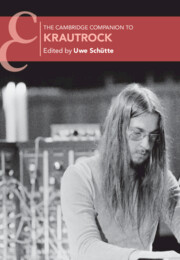Book contents
- The Cambridge Companion to Krautrock
- Cambridge Companions to Music
- The Cambridge Companion to Krautrock
- Copyright page
- Dedication
- Contents
- Illustrations
- Contributors
- Acknowledgements
- Note on Translation
- Introduction
- Part I Context
- Part II Music
- 6 Kraftwerk
- 7 Can
- 8 Tangerine Dream
- 9 Neu!
- 10 Faust
- 11 Cluster/Harmonia
- 12 Popol Vuh
- 13 Ash Ra Tempel, Manuel Göttsching, and Klaus Schulze
- 14 Amon Düül II
- 15 The Flip Side of Krautrock
- Part III Legacy
- Index
11 - Cluster/Harmonia
from Part II - Music
Published online by Cambridge University Press: 20 October 2022
- The Cambridge Companion to Krautrock
- Cambridge Companions to Music
- The Cambridge Companion to Krautrock
- Copyright page
- Dedication
- Contents
- Illustrations
- Contributors
- Acknowledgements
- Note on Translation
- Introduction
- Part I Context
- Part II Music
- 6 Kraftwerk
- 7 Can
- 8 Tangerine Dream
- 9 Neu!
- 10 Faust
- 11 Cluster/Harmonia
- 12 Popol Vuh
- 13 Ash Ra Tempel, Manuel Göttsching, and Klaus Schulze
- 14 Amon Düül II
- 15 The Flip Side of Krautrock
- Part III Legacy
- Index
Summary
This chapter examines the music created by Hans-Joachim Roedelius, Dieter Moebius, and Michael Rother, under the band names Cluster and Harmonia. It makes the case that this music exists in a different relation to post-war Germany than that of Kraftwerk or Neu. Cluster/Harmonia created music deeply informed by the rural setting in which the musicians worked; in doing so, they engaged with one of the archetypal signifiers of German identity – the German landscape. The improvisatory nature of their work both allowed them to respond directly to the influence of their environment, but also created a template that proved very influential – not least on the work of Brian Eno (who collaborated with them in the mid-1970s).
- Type
- Chapter
- Information
- The Cambridge Companion to Krautrock , pp. 173 - 186Publisher: Cambridge University PressPrint publication year: 2022

